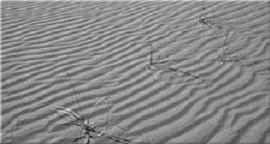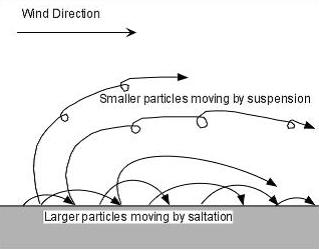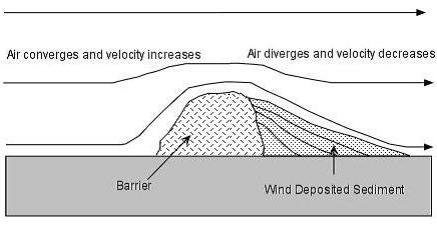Sand and wind

loose sand
Loose gravel is classified by the size of its particles. Fine sand grains are generally between 0.2 mm and 1.6 mm. The size, mineral composition and shape of the grains have an effect on the transfer and accumulation of sand. Any non-cohesive natural or man-made particle within the range of particle size and shape can act as quicksand. Because dry and non-sticky snow particles are driven by the wind and piled up.
Almost all particles of loose sand, quartz are found in abundance in the building. This is due to the properties of quartz particles. Quartz particles are very hard and are very resistant to erosion caused by chemicals or mechanical pressures and do not get smaller than a certain size. In this way, erosion affects other minerals and turns them into smaller particles and dust, and quartz particles remain.
In desert areas, wind blowing is normal. Because the air near the surface of the earth is heated and rises up and the cold air away from the earth fills its place, this movement leads to wind. Although the wind plays the main role in the movement and storage of sand, water and ice are the main factors in eroding rocks and crushing them into particles the size of sand grains. Wind also affects the formation of sand grains. The sand particles are scraped together by the force of the wind and become rounded. For this reason, desert sands are rounder than beach sands and are moved a longer distance.
Wind, the agent of sand movement

Jumping movement and creeping movement
Sand grains move under the force of the wind. This movement takes place in one of two ways: saltation and surface creep.
In general, 75% of sanddisplacement is caused by jump movement of sand grains. When the wind blows over the sand pile, it is able to separate the sand grains from the surface and move them in the direction of its wind. The weight of sand grains causes these grains to return to the surface. (Continues...)

Jumping movement of quicksand
Types of jump-type movement
• If the surface consists of a combination of sand grains and hard and rough objects, such as stones, after hitting hard surfaces, the sand particles are again deflected upwards and pushed forward by the wind once again. be. The movement speed of sand particles in such conditions reaches half of the wind speed.
• If the surface consists of a combination of sand grains and softer and smaller particles, the sand grain will be buried after hitting the soft surface. Until it is again forced by the wind to bounce and push forward. The movement speed of this method is lower than wind blowing on hard and rough surfaces.
Since the weight of sand particles is 2000 times that of air, they do not bounce with every gust of wind. The wind must reach the "fluid threshold" speed to be able to move the sand to the jump. The "threshold" speed is the speed at which sand can jump forward.
The "threshold" speed is directly related to the size of the sand grains and varies between 10 and 20 miles per hour. After the jump of sand grains, the wind blowing with a speed lower than the movement threshold is also able to continue moving the sand.
With the beginning of the jump movement of the sand, there is no need to blow the wind directly to the surface in order to separate the sand from the surface. Hitting the moving sand grain with the surface sand is able to provide enough energy to throw the sand grain into the air and start its flight. (Assuming that the surface is sandy)
Thus, high-speed wind is only needed to start moving the sand, and after that, maintaining the flow of sand jump is also provided by gentle wind.
The speed that provides the jump of sand is called "impact threshold". Bagnold believes that the average result of the force required to continue the jump of sand grains is almost equal to the result of the force resulting from the impact of flying grains. Energy loss is also provided by gentle wind.
As with the "threshold movement" speed, the "threshold impact" speed also increases with increasing sand grain size.

When the wind passes through the obstacles, it loses its speed and leaves the grains of sand behind
Creep movement
... is the type of movement changes with the increase of grain dimensions. Larger, heavier seeds are not moved by direct wind pressure, and only strong winds can directly affect these seeds.
Grains larger than 1 mm are generally displaced by surface creep. When bouncing sand grains collide with these large particles, they do not have enough power to lift them into the air. But the collision of large sand grains with these coarse particles causes them to creep forward. These fragments may have a mass 200 times the mass of the grains of jumping sand.
25% of the movement of sand is done by surface creep.
Sand accumulation
Sand accumulation requires two main factors.
1- Sufficient amount of sand.
2- Strong and permanent wind flow for the accumulation of sand.
If the above two conditions are met simultaneously, they can move huge amounts of sand for kilometers.
In general, the decrease in the speed of the wind flow leads to storage mounds and the accumulation of sand. Sands tend to pile up near any obstacles on the surface as they move. Because the obstacles, whether they are stones, trees, bushes, or man-made, reduce the speed of the wind, and accumulate sand around the mound itself. This phenomenon is called "sand shadow". Also, any dimples or gentle bumps on smooth surfaces can also lead to sand accumulation.
While sand accumulates around obstacles, the presence of obstacles is not required for sand to accumulate. Sand itself has the ability to accumulate. This "self-accumulation" occurs for two reasons:
1- the difference in the speed of sand particles when entering from a sandy surface to a non-sandy surface.
2- Changing the wind speed and its effect on sand movement.
June 08, 2022
